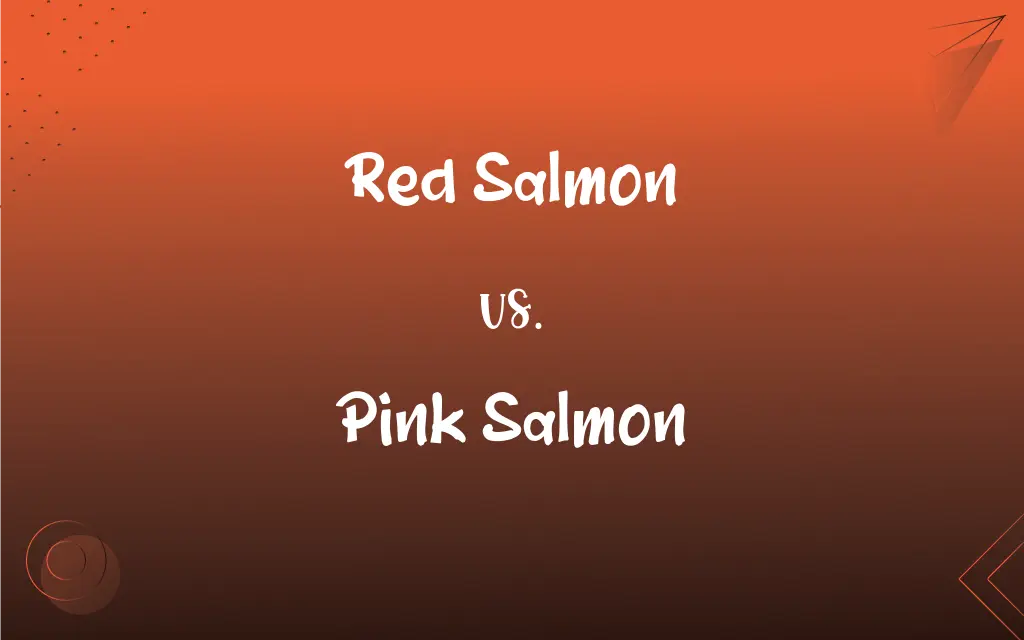Red Salmon vs. Pink Salmon: What's the Difference?
Edited by Aimie Carlson || By Harlon Moss || Updated on October 15, 2023
Red salmon (Sockeye) is known for its richer flavor and firmer texture, while Pink salmon (Humpy) is milder and softer.

Key Differences
Red salmon, or Sockeye, is a term used for one of the species of salmon found primarily in the Northern Pacific, renowned for its deep red color, rich flavor, and high oil content. In contrast, pink salmon, known as Humpy, is the most widespread species of the Pacific salmon family, characterized by its lighter pink flesh, milder flavor, and lower fat content.
In terms of habitat, both red salmon and pink salmon thrive in different environments. Red salmon are known for their unique life cycle that includes part of their juvenile growth in lakes before heading to the ocean, making their habitat slightly different from pink salmon, which generally migrate to the ocean shortly after being hatched.
When it comes to commercial value and consumption, red salmon is often considered superior due to its rich taste and firmer texture, making it a favorite in high-end culinary preparations. Pink salmon, though not as rich in flavor, is extremely popular due to its abundance and affordability, often canned or used in processed foods.
Regarding their physical characteristics, red salmon are recognized for their bright red flesh, a result of their diet, which includes a large number of krill and plankton. On the other hand, pink salmon have a paler, pink flesh, and are smaller in size compared to red salmon, with a less pronounced flavor profile.
Finally, the spawning process of both species is fascinating. Red salmon are known for their incredible journey back to their natal streams, a journey that changes their body color dramatically. Pink salmon, although they also return to their birthplace to spawn, have a two-year lifecycle, the shortest of any Pacific salmon, leading to high population numbers but less individual growth time.
ADVERTISEMENT
Comparison Chart
Species Name
Sockeye
Humpy
Color
Deep red
Light pink
Flavor
Rich, robust
Mild, delicate
Texture
Firm
Softer
Usage in Food
Often fresh or smoked
Commonly canned
ADVERTISEMENT
Red Salmon and Pink Salmon Definitions
Red Salmon
"Red salmon" undergoes a dramatic physical transformation during its spawning phase.
Observers marvel at the red salmon's change from ocean blue to river red.
Pink Salmon
"Pink salmon" males develop a pronounced hump on their backs during the spawning season, giving them the nickname "humpies."
Children were excited to see the humpbacked pink salmon at the stream.
Red Salmon
"Red salmon" is often more expensive than other salmon due to its perceived quality.
Despite the high price, red salmon is their best-selling dish.
Pink Salmon
"Pink salmon" is the common name for the species Oncorhynchus gorbuscha, recognized for its pale pink flesh.
We're having smoked pink salmon for dinner tonight.
Red Salmon
"Red salmon" refers to the Sockeye salmon species known for its deep red flesh.
The chef recommends the red salmon due to its exceptional taste.
Pink Salmon
"Pink salmon" is the most abundant Pacific salmon species and is often canned or processed.
Can you pick up some canned pink salmon from the grocery store?
Red Salmon
"Red salmon" habitats are typically in northern Pacific waters and certain freshwater lakes.
Environmentalists are working to protect the red salmon's natural habitats.
Pink Salmon
"Pink salmon" has a milder flavor and softer texture compared to other types of salmon.
Pink salmon is perfect for people who prefer a milder fish flavor.
Red Salmon
"Red salmon" is prized in culinary circles for its rich, robust flavor and high oil content.
Connoisseurs appreciate red salmon for its superior quality and texture.
Pink Salmon
"Pink salmon" have a two-year life cycle, the shortest among Pacific salmon species.
The abundance of pink salmon this year is due to their short life cycle.
FAQs
What is "red salmon"?
Red salmon refers to a species of salmon, known scientifically as Oncorhynchus nerka, commonly found in the Northern Pacific Ocean and rivers discharging into it.
Is there a difference between red and pink salmon?
Yes, red salmon and pink salmon are different species. Red salmon are larger and have a more intense flavor and higher oil content compared to pink salmon.
What is "pink salmon"?
Pink salmon, or Oncorhynchus gorbuscha, is the smallest and most abundant Pacific salmon species, known for the distinctive pink hue of its flesh.
Can you interchange red and pink salmon in recipes?
They can be substituted for each other, but there will be differences in taste and texture due to the inherent qualities of each species.
Why is red salmon also called "sockeye"?
The name "sockeye" is believed to be a derivation of "sukkai," a word from a Native American language, referring to the fish's distinctive red color.
Are pink salmon and "humpies" the same?
Yes, "humpies" is a colloquial term for pink salmon, inspired by the pronounced hump male salmon develop on their backs during spawning season.
Which has a stronger taste, red or pink salmon?
Red salmon typically has a stronger, more robust flavor compared to the milder taste of pink salmon.
Are there color differences in the flesh of red and pink salmon?
Yes, red salmon has a deep red or orange flesh, while pink salmon has a lighter pink color.
Is there a nutritional difference between red and pink salmon?
Both are nutritious, but red salmon has a higher content of omega-3s and overall fat, while pink salmon has a lower fat content and calorie count.
Can both red and pink salmon be found in cans?
Yes, both types of salmon are canned, though red salmon is often more expensive than pink due to its richer flavor and texture.
What are the common preparations for red and pink salmon?
Both can be grilled, baked, broiled, or pan-fried. Red, with its richer flavor, is also popular for smoking, while pink is commonly used in salads or sandwiches.
Which is more expensive, red or pink salmon?
Red salmon is generally more expensive due to its richer taste, firmer texture, and higher oil content.
Are red and pink salmon both safe for consumption?
Absolutely, both red and pink salmon are safe and healthy to eat, rich in protein, omega-3 fatty acids, and various vitamins.
Why are they called "red" and "pink" salmon?
The names refer to the color of their flesh, with red salmon having a deeper red hue and pink salmon a lighter pink.
Are there habitat differences between red and pink salmon?
Both species are found in the Pacific Ocean, but red salmon are primarily in freshwater or coastal waters, while pink salmon are more prevalent in open ocean areas.
How important are red and pink salmon to commercial fishing?
Both are vital to the fishing industry, though pink salmon, due to their abundance, often make up a larger portion of commercial catches.
Are red and pink salmon populations at risk?
Some local populations face challenges due to overfishing, habitat loss, and climate change, but conservation efforts are in place to protect both species.
Are red and pink salmon available year-round?
Fresh red and pink salmon have peak seasons but frozen, smoked, or canned versions are typically available year-round.
Do red and pink salmon have different spawning behaviors?
Yes, while both species spawn in freshwater, the timing and exact nature of their spawning rituals vary, with pink salmon having a two-year life cycle.
Can red and pink salmon be farmed?
Yes, both species can be farmed, though farming practices and sustainability can vary greatly by region and producer.
About Author
Written by
Harlon MossHarlon is a seasoned quality moderator and accomplished content writer for Difference Wiki. An alumnus of the prestigious University of California, he earned his degree in Computer Science. Leveraging his academic background, Harlon brings a meticulous and informed perspective to his work, ensuring content accuracy and excellence.
Edited by
Aimie CarlsonAimie Carlson, holding a master's degree in English literature, is a fervent English language enthusiast. She lends her writing talents to Difference Wiki, a prominent website that specializes in comparisons, offering readers insightful analyses that both captivate and inform.
































































